Hamilton's future land use will be debated at an upcoming meeting on June 21 to review proposed changes to the Greenbelt, including two Hamilton areas proposed for removal.
By John Bacher
Published June 03, 2016
With the unique spectacular beauty of the well-forested Niagara Escarpment and the tender fruit belt below it stretching to Lake Ontario, Hamilton has been at the forefront of debates about provincial land use planning for more than the last half-century.
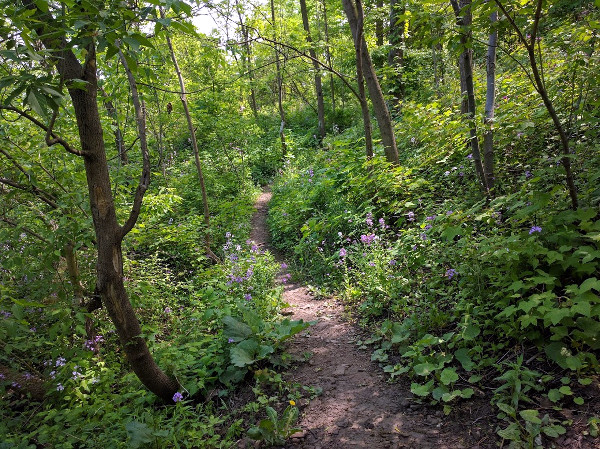
Forest trail on Niagara Escarpment in central Hamilton (RTH file photo)
What provincial land use planning means are controls established through the more durable and remote control of the province. The need for it has been based on the realistic assumption that municipal planning will always be reflective of the dominance of developers.
Although there were some isolated mavericks in Toronto who urged provincial land use planning to create a greenbelt around the city connected with river corridors to Lake Ontario during the Second World War, the great thrust for the reform emerged in Hamilton.
The Hamilton Field Naturalists Club was founded in 1919 after the First World War through the leadership of Thomas McQuesten, whose work as a city councillor and parks commissioner drove the reforestation of the Escarpment.
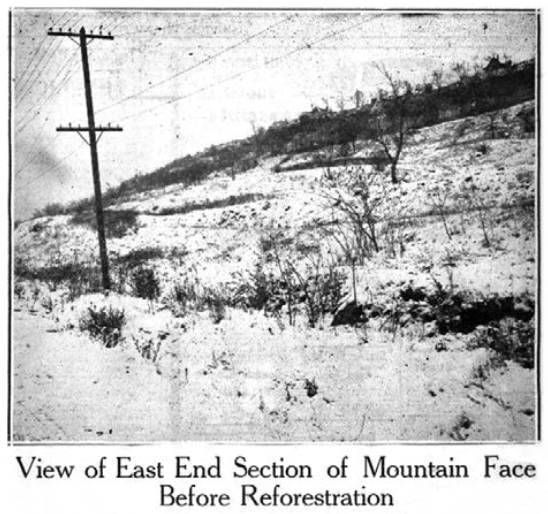
Niagara Escarpment, Hamilton in 1930 before reforestation (Image Credit: Hamilton Free Press)
The Naturalists Club became the nature-loving intellectual salon from which the concept of greenbelt protection emerged. While Thomas McQueston had died a decade earlier, his brother Calvin continued to be active in the organization.
One of their number, Dr. Norman Pearson, was the planning director for Wentworth County, which then encompassed the city's suburbs. Other giants of the club included the artist, Robert Bateman, and Ray Lowes, who conceived of the concept of the Bruce Trail along the length of the Escarpment.
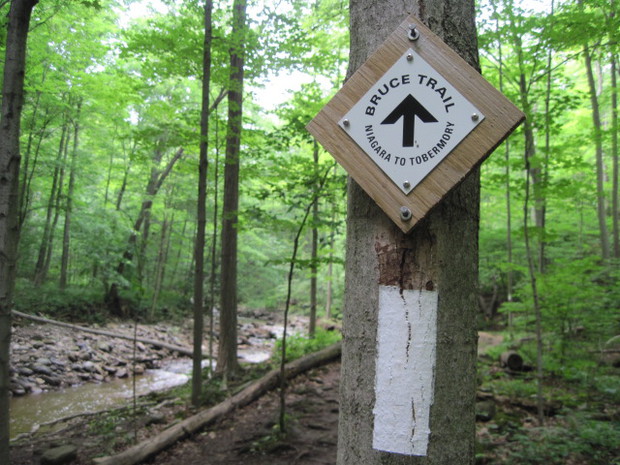
Bruce Trail sign and blaze (Image Credit: Bruce Trail Conservancy)
Pearson became the driving force behind a proposal for a provincial park from Hamilton to the Niagara River along the Escarpment. The report he authored would be quite eloquent about what subsequently would be key goals of provincial land use planning.
His report called the Escarpment "A symphony of rugged grandeur, broad vistas, history lore, primitive beauty." It contained a moving photograph of a vista from the Escarpment to Lake Ontario with blossoming fruit trees and warned, "Must all this pass with the ruthless sweep of change?"
Since the province rejected the Escarpment Provincial Park concept, the naturalists mobilized around creating the Bruce Trail as an impetus to push forward provincial land use planning. Ray Lowes urged that the Bruce Trail be built to secure public support from "a green belt crossing Ontario."
Lowes' dream of a provincial Greenbelt proceeded slowly, but he was able to live long enough to realize his vision in 2005. First the Niagara Escarpment Plan was originally developed in 1985, followed by the Oak Ridges Moraine Conservation Plan in 2002.
Then in 2005 came the establishment of the Ontario Greenbelt. Its core strength comes from two features - the imposition of permanent urban boundaries on the fruit belt and a ten-year freeze on urban boundary expansions in the rest of the Greenbelt.
After a year of acrimonious review, the provincial government has now come up with proposals for the mandated ten-year review of the Greenbelt Plan.
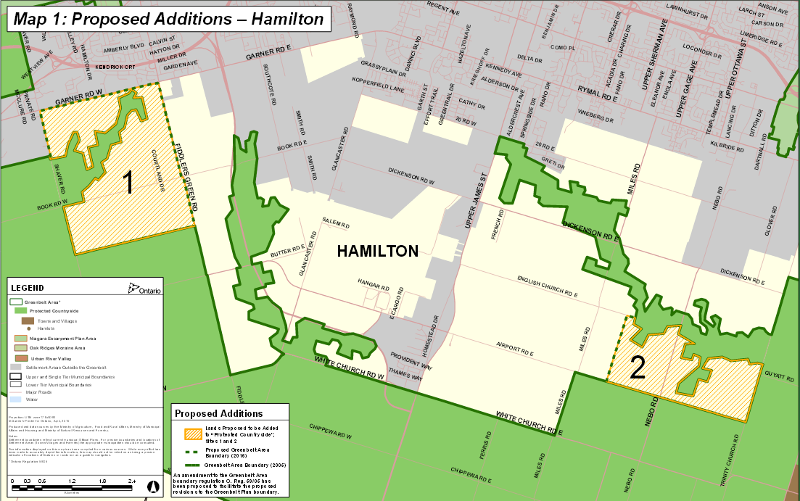
Proposed Hamilton additions to the Greenbelt
Although the Province has reaffirmed the permanence of urban boundaries on the fruit lands, what is being proposed for the rest of the plan area is deeply disturbing. This collapse in policy was encouraged by the City of Hamilton having several town hall meetings, which mobilized opponents of Greenbelt protections.
It is proposed to immediately remove two areas in Hamilton from the Greenbelt.
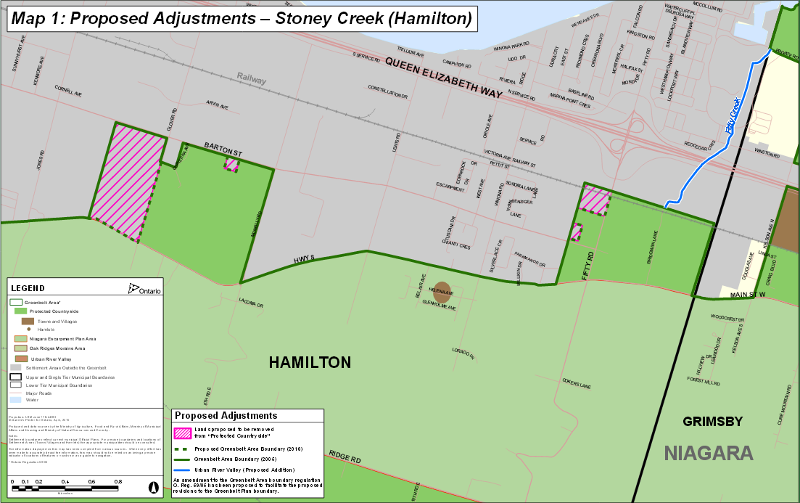
Two Hamilton areas proposed for removal from the Greenbelt
There is also a proposal to end the freeze on what the Greenbelt Plan calls the Protected Countryside. This area in the future will become subject to possible urban boundary expansions during the five-year consolidated review of Hamilton's Official Plan. There are also a deluge of proposed urban boundary expansions being proposed for the Niagara Escarpment Plan area.
The province is holding a consultation meeting on the Greenbelt:
It is to be hoped that those who come out will have the passion and vision to secure a Greenbelt worthy of its Hamiltonian founders. Not only should the existing freezes continue but what is termed the "white belt" of agriculturally zoned land around the headwaters of the Welland River and Twenty Mile Creek should become part of a truly protected countryside.
With its huge brownfields typical of a rust belt, Hamilton's future depends on protecting what Pearson called it symphony of rugged grandeur, vistas and primitive beauty.
By iancborsuk (registered) - website | Posted June 03, 2016 at 10:34:36
Environment Hamilton will be hosting TWO pre-Greenbelt meeting workshops for all those interested. Information can be found here: http://www.environmenthamilton.org/view/...
By good (anonymous) | Posted June 03, 2016 at 13:53:33
good to see bacher in 'print' again, even if here
By mayornot (registered) | Posted June 04, 2016 at 12:48:36
Dope RTH says this message is SPAM when it was anonymous!
The Spectator would do well to get Mr Bacher to write about this, he is expert on this:
Mayor Eisenberger pushes for national housing strategy
Mayor Fred Eisenberger wants a National Housing Strategy to help address the housing crisis
By Kelly Noseworthy, CBC News Posted: Jun 03, 2016 10:35 PM ET Last Updated: Jun 03, 2016 10:35 PM ET
By Easymoney (anonymous) | Posted June 04, 2016 at 20:23:53
There has already been far too much land placed in the 'Green Belt'.
The HRC has far too much power and must be hobbled immediately.
Peoples retirement plans and many other things have been ruined by this outrageous Belt.
Even Water Pipelines are banned!!!! Too much protection is worse than not enough.
The Strangulation Belt should only be reduced, NEVER expanded.
By Unlivable (anonymous) | Posted June 06, 2016 at 13:10:41 in reply to Comment 119071
The "strangulation belt" help reduce the effects of smog, excess rainfall, and rising temperatures on built up areas (to name but a few things). You might think it's progress to build, build, build, but not if what you're left with is unlivable.
By glend1967 (registered) | Posted June 05, 2016 at 06:52:45
Once again placing peoples interest above the planets.Lets pave it all!!
By John Bacher (anonymous) | Posted June 05, 2016 at 18:08:57
Those who want to pave it all are full of the narrow myopic greed the Greenbelt seeks to protect us from.
By better idea (anonymous) | Posted June 06, 2016 at 12:40:59
Be better if in these strange housing times John Bacher wrote an article for Toronto Star, or Globe [not Spectator] where they might pay a few dollars, on a background history of Canada's national housing policy--where it came from & why there was one, once. I would read it. Some people in Hamilton go read more than the Spec or listen to
By Lives in the greenbelt (anonymous) | Posted June 09, 2016 at 07:49:24
Could John add a map where the legend is readable digitally? Its pretty blurry and I'd love to know what the beige slanted lines in #1 & #2 areas stand for...
By timselles (registered) | Posted June 09, 2016 at 12:18:22 in reply to Comment 119203
Link to hi-res map at Environment Hamilton:
You must be logged in to comment.
There are no upcoming events right now.
Why not post one?